Welcome to the fascinating world of the Red Fody, a vivacious avian gem that commands attention with its fiery red plumage set against the verdant landscapes of Madagascar and beyond. This captivating bird species, adorned in nature’s palette, captivates bird enthusiasts worldwide.
Delving into their realm unveils unique mating rituals and nesting behaviors, showcasing remarkable sexual dimorphism as males transform from dull brown to striking red during the breeding season.
Their distinctive nests, resembling woven baskets, further accentuate their charm. Yet, our journey has only just begun to unravel the mysteries of the Red Fody.
Join us as we delve deeper into the enchanting world of this avian marvel, uncovering the secrets that make it a captivating spectacle for birdwatchers and ornithologists alike.
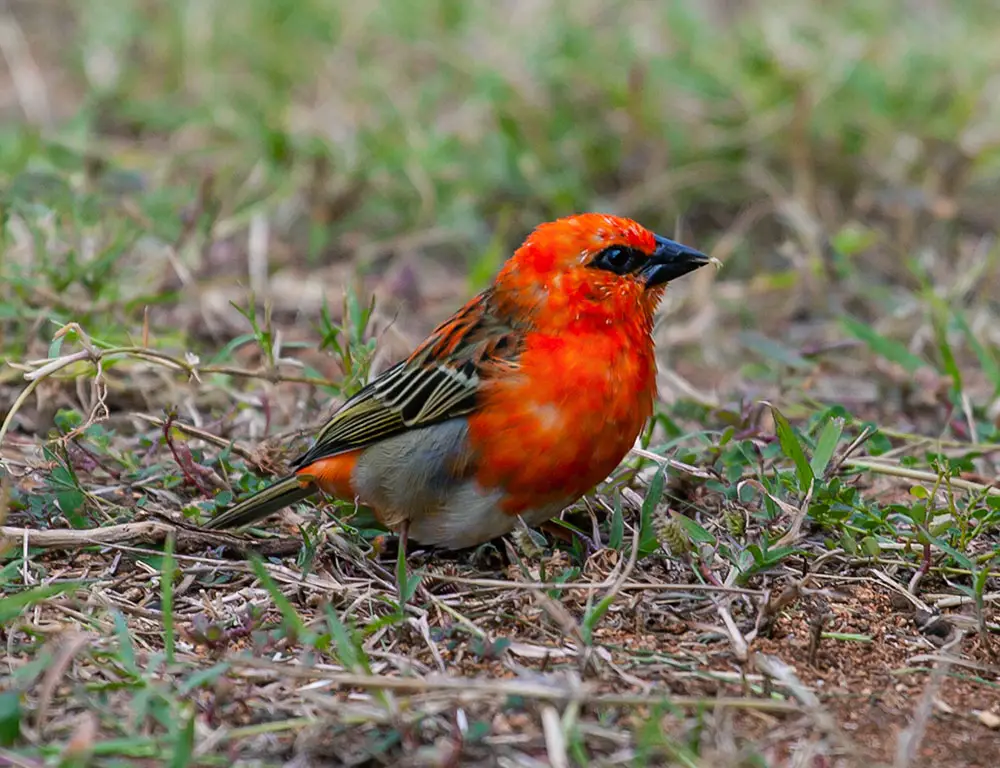
Physical Characteristics of Red Fody
The Red Fody (Foudia madagascariensis) is a small bird species native to Madagascar, characterized by several distinctive physical traits:
Plumage
The most striking feature of the Red Fody is its attractive bright red plumage, especially prominent in males during the breeding season. This fiery red coloration contrasts sharply with their black wings and tail feathers.
In contrast, females and juveniles typically have more subdued olive-brown plumage.
Size and Shape
Red Fodies are petite birds, measuring approximately 4-5 inches (10-13 cm) in length on average. Their sleek, compact body structure and relatively rounded wings facilitate agile flight maneuvers through their forest habitats. Despite their small size, they exhibit energetic and charismatic behavior.
Weight
These birds are lightweight, usually tipping the scales at around 0.49-0.67 ounces (14 -19 grams). Their lightness aids in their flight capabilities and agility.
Sexual Dimorphism
One notable aspect of Red Fodies is sexual dimorphism, where males and females exhibit differences in appearance.
During the breeding season, male Red Fodies transform from dull brown plumage to intense scarlet, enhancing their attractiveness to potential mates.
Females, on the other hand, retain their more subdued coloration throughout the year.
Habitat and Distribution of Red Fody
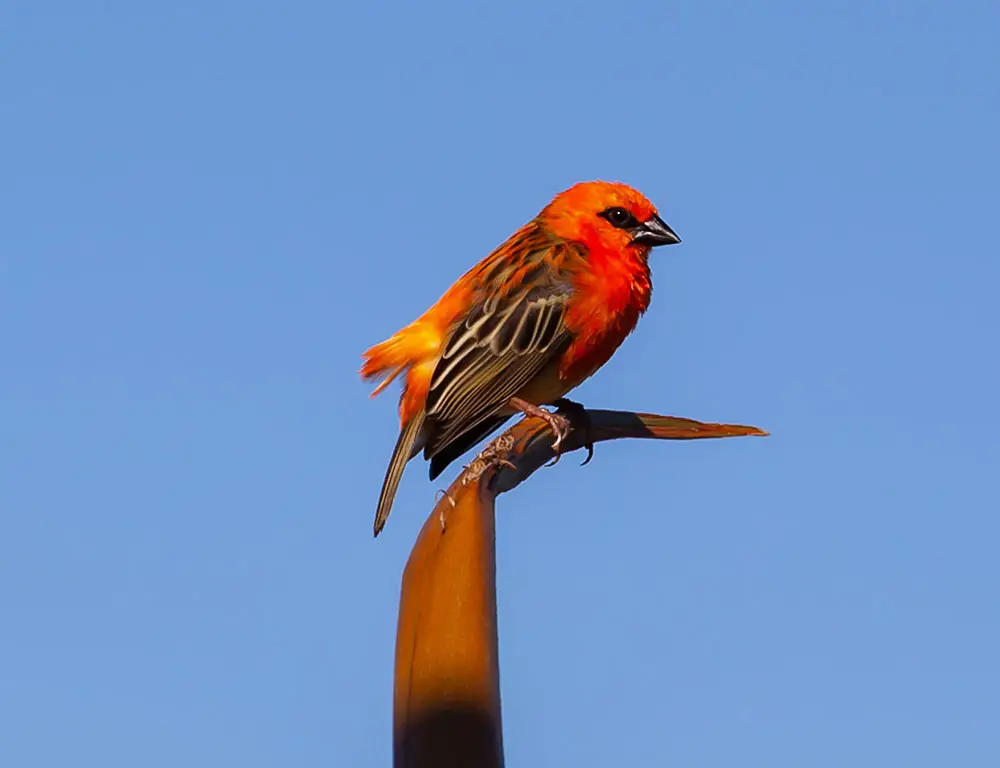
The Red Fody (Foudia madagascariensis) is a bird species native to Madagascar, but it has also been introduced to various other regions. Here’s a detailed look at its habitat and distribution:
Native Habitat
The Red Fody is indigenous to Madagascar, occupying various habitats across the island. These habitats include rainforests, dry deciduous forests, grasslands, wetlands, and cultivated areas.
They are ubiquitous in the eastern rainforests of Madagascar but can also be found in urban and suburban environments.
Indian Ocean Islands
In addition to Madagascar, the Red Fody has also spread to other islands in the Indian Ocean, including the Seychelles and Mauritius.
It has been introduced to these islands and has established populations, often thriving in similar habitats to its native range.
Introduced Populations
Introducing Red Fodies to other regions has led to established populations outside of their native range. These introduced populations can sometimes become invasive, particularly on islands where they can outcompete native bird species for resources.
Urban and Rural Environments
Red Fodies are adaptable birds that can thrive in a range of environments, including both natural and human-altered landscapes.
They are commonly found in gardens, parks, agricultural areas, and residential neighborhoods, exploiting food sources such as seeds, insects, and fruits.
Altitude Range
Red Fodies are found at varying altitudes, ranging from sea level to around 2000 meters. This broad altitudinal range demonstrates their versatility and ability to adapt to different elevations within their habitat.
Diet of Red Fody
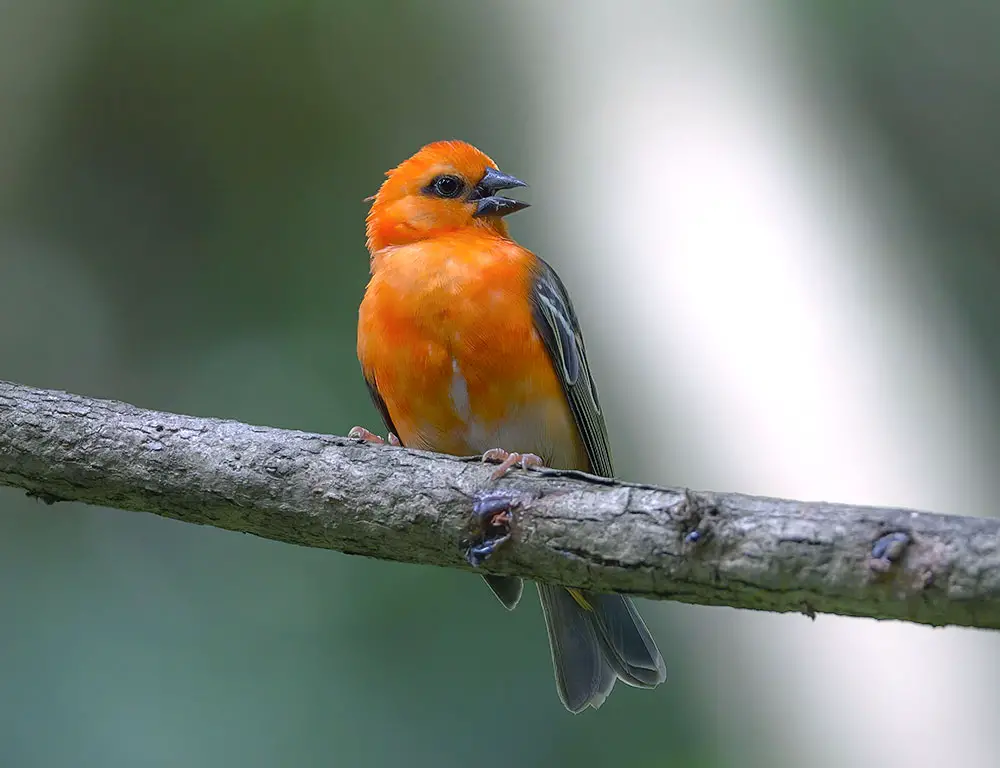
The diet of the Red Fody (Foudia madagascariensis) is varied and includes a combination of seeds, insects, and fruits.
Here’s a detailed breakdown of their dietary preferences and feeding behavior:
Seeds
Red Fodies are primarily seed-eaters, with seeds from grasses forming a significant part of their daily diet. They have solid and conical bills adapted for cracking open seeds and are often seen foraging for seeds on the ground or in vegetation.
Insects
While seeds comprise the bulk of their diet, Red Fodies also consume insects, especially during the breeding season when they require additional protein for egg production and chick-rearing. They may hunt for insects in foliage or catch them in mid-air during flight.
Fruits
Red Fodies supplement their diet with various types of fruits, including berries and figs. Fruits provide essential vitamins and minerals and are necessary during periods when seeds may be less abundant.
Foraging Behavior
Red Fodies exhibit active and social foraging behavior. They are often seen foraging in small groups or pairs, moving through their habitat in search of food sources. They are versatile feeders, exploring habitats like forests, grasslands, and cultivated areas.
Unique Feeding Behaviors
Red Fodies display some unique feeding behaviors that distinguish them from other bird species:
- Hanging Upside Down: Red Fodies hang upside down from branches while picking off insects or reaching for berries. This behavior allows them to access food sources that may be difficult for other birds.
- Ground Foraging: While many bird species primarily forage in trees and shrubs, Red Fodies are comfortable combing through ground cover for seeds and insects. This adaptability enables them to exploit a wide range of food resources.
Behavior of Red Fody
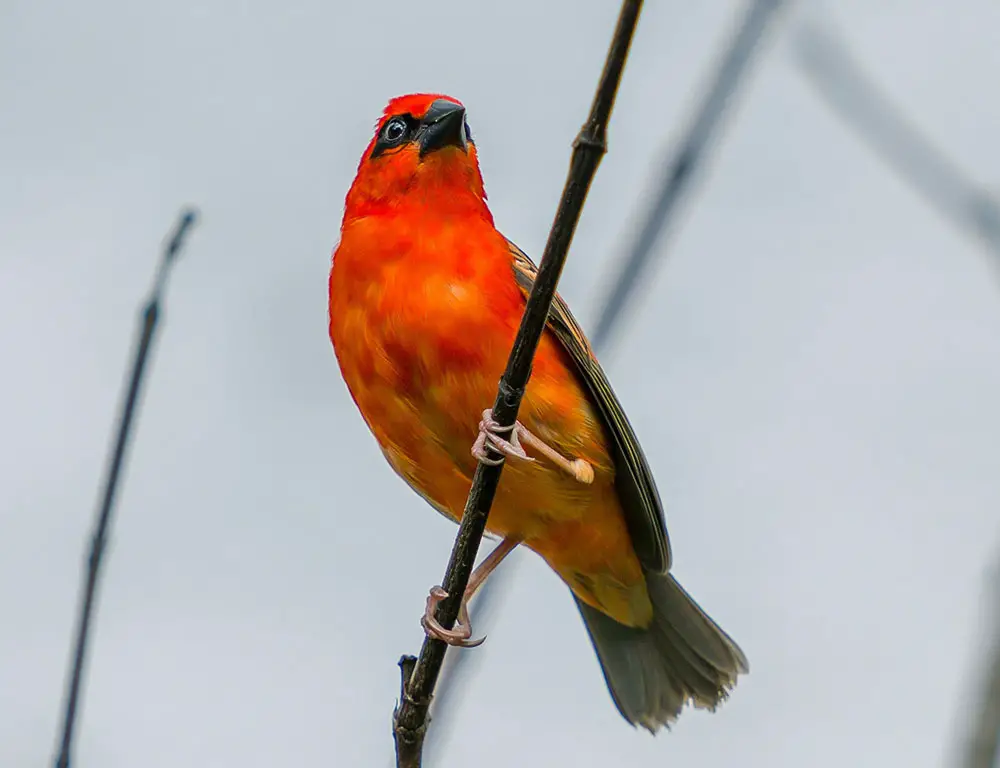
The Red Fody (Foudia madagascariensis) exhibits various fascinating behaviors contributing to its survival and reproduction.
Here are some key aspects of the behavior of Red Fodies:
Breeding Behavior
- Polygynous Mating: Male Red Fodies are polygynous, meaning they mate with multiple females during each breeding season. They display vivid red plumage during this time to attract mates.
- Nest Building: Male Red Fodies initiate nest construction before securing a mate. They build intricate nests of grasses, leaves, and twigs, often located among reeds or in low trees and shrubs.
- Courtship Displays: Male Red Fodies use elaborate courtship displays to attract females, showcasing their bright plumage and performing vocalizations.
- Parental Care: Both parents share duties in feeding and caring for the chicks after they hatch. The female contributes by lining the nest with soft materials for insulation and comfort.
Social Behavior
- Communal Roosting: Outside of the breeding season, Red Fodies form large communal roosts, sometimes consisting of thousands of individuals. Despite their size, these gatherings exhibit a surprising level of harmony among the birds.
- Foraging in Groups: Red Fodies often forage in small groups or pairs, displaying social behavior while searching for food sources such as seeds, insects, and fruits.
Feeding Behavior
- Active Foraging: Red Fodies are active foragers exploring various habitats for food. They hang upside down from branches while feeding on insects or reaching for berries.
- Ground Foraging: Unlike some bird species that primarily forage in trees, red frogs are comfortable feeding on the ground, searching for seeds and insects in ground cover.
Molting Behavior
Male Red Flies undergo seasonal plumage changes, transitioning from dull brown to red during the breeding season. This change in coloration is associated with hormonal changes and is linked to reproductive behavior.
Communication
Red Fodies have a repertoire of vocalizations, including sweet and melodic songs. Their vocalizations can vary from plaintive notes to excited chirps, depending on the context and social interactions.
Conservation Status of Red Fody
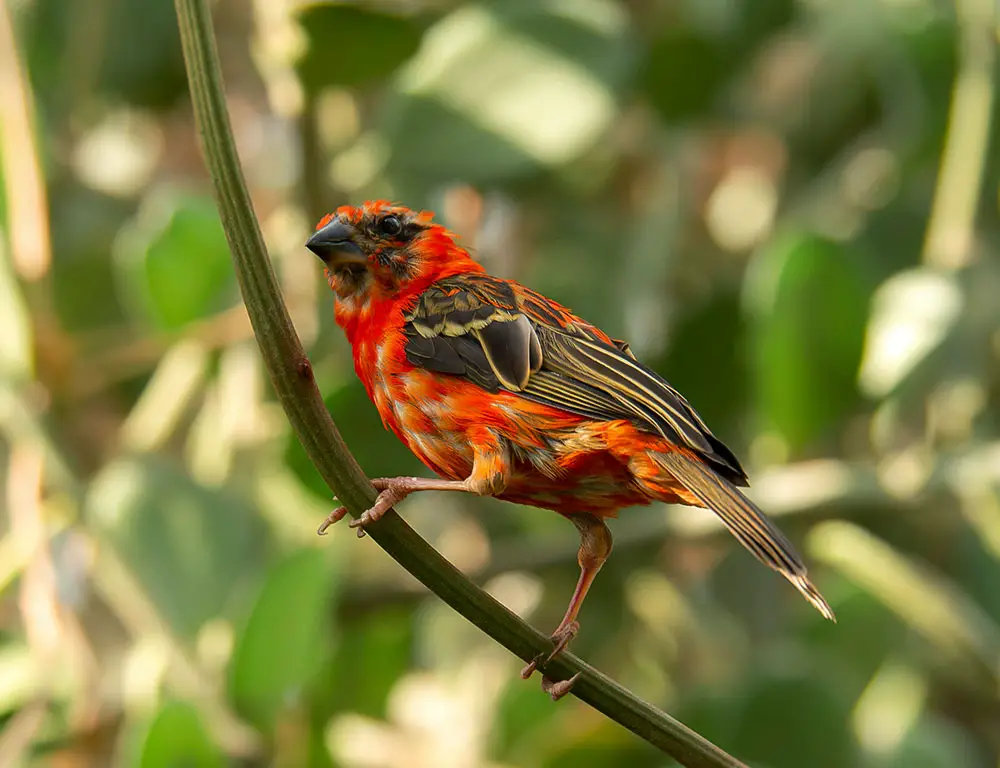
The conservation status of the Red Fody (Foudia madagascariensis) is currently assessed as “Least Concern” by the International Union for Conservation of Nature (IUCN).
This classification indicates that the species is not considered to be facing immediate threats of extinction.
However, there are still concerns about the long-term conservation of the Red Fody due to various factors:
Habitat Loss
Deforestation and habitat degradation are significant threats to the Red Fody, particularly in its native range of Madagascar. Loss of forested areas to agriculture, logging, and urbanization reduces suitable habitat for the species and can lead to population declines.
Invasive Species
Introducing non-native species, such as predators or competitors, can negatively impact the Red Fody’s population. Invasive species may prey upon Red Fody eggs or chicks, compete for resources, or alter habitat dynamics, posing additional threats to the species.
Cage Bird Trade
The Red Fody is sometimes captured for the cage bird trade, particularly in areas it has been introduced outside its native range.
Overcollection for the pet trade can deplete local populations and disrupt natural behaviors, affecting the species’ overall conservation status.
Climate Change
Climate change may also indirectly threaten the Red Fody by altering habitat suitability, affecting food availability, and increasing the frequency and intensity of extreme weather events.
These changes could impact the species’ reproductive success, survival rates, and overall population dynamics.
Conclusion
The Red Fody’s plumage and captivating behaviors underscore its significance within its native ecosystems. Beyond mere aesthetics, their bright colors serve vital roles in survival, from attracting mates to signaling strength against predators.
The Red Fody maintains biodiversity as a seed disperser, particularly in Madagascar. Yet, habitat loss threatens their existence, with urbanization and deforestation encroaching upon their homes.
Conservation efforts are imperative to safeguard these colorful creatures. By understanding their habits and habitats, we can take meaningful steps towards their preservation.
Let us be inspired to advocate for their protection, ensuring that future generations can continue to marvel at the beauty and importance of the Red Fody.
Each creature, including the Red Fody, plays an integral role in nature’s intricate balance and is deserving of our utmost care and conservation efforts.